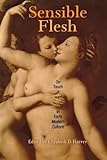Sensible Flesh : On Touch in Early Modern Culture / ed. by Elizabeth D. Harvey.
Material type: TextPublisher: Philadelphia : University of Pennsylvania Press, [2020]Copyright date: ©2003Description: 1 online resource (328 p.) : 11 illusContent type:
TextPublisher: Philadelphia : University of Pennsylvania Press, [2020]Copyright date: ©2003Description: 1 online resource (328 p.) : 11 illusContent type: - 9780812293630
- 152.182 23
- online - DeGruyter
| Item type | Current library | Call number | URL | Status | Notes | Barcode | |
|---|---|---|---|---|---|---|---|
 eBook
eBook
|
Biblioteca "Angelicum" Pont. Univ. S.Tommaso d'Aquino Nuvola online | online - DeGruyter (Browse shelf(Opens below)) | Online access | Not for loan (Accesso limitato) | Accesso per gli utenti autorizzati / Access for authorized users | (dgr)9780812293630 |
Frontmatter -- Contents -- 1 Introduction: The "Sense of All Senses" -- 2 Anxious and Fatal Contacts: Taming the Contagious Touch -- 3 "Handling Soft the Hurts": Sexual Healing and Manual Contact in Orlando Furioso, The Faerie Queene, and All's Well That Ends Well -- 4 The Subject of Touch: Medical Authority in Early Modern Midwifery -- 5 The Touching Organ: Allegory, Anatomy, and the Renaissance Skin Envelope -- 6 As Long as a Swan's Neck? The Significance of the "Enlarged" Clitoris for Early Modern Anatomy -- 7 New World Contacts and the Trope of the "Naked Savage" -- 8 Noli me tangere: Colonialist Imperatives and Enclosure Acts in Early Modern England -- 9 Acting with Tact: Touch and Theater in the Renaissance -- 10 Living in a Material World: Margaret Cavendish's The Convent of Pleasure -- 11 Touch in the Hypnerotomachia Poliphili: The Sensual Ethics of Architecture -- 12 The Touch of the Blind Man: The Phenomenology of Vividness in Italian Renaissance Art -- Afterword: Touching Rhetoric -- Notes -- Contributors -- Index -- Acknowledgments
restricted access online access with authorization star
http://purl.org/coar/access_right/c_16ec
This ground-breaking interdisciplinary collection explores the complex, ambiguous, and contradictory sense of touch in early modern culture. If touch is the sense that mediates between the body of the subject and the world, these essays make apparent the frequently disregarded lexicons of tactility that lie behind and beneath early modern discursive constructions of eroticism, knowledge, and art. For the early moderns, touch was the earliest and most fundamental sense. Frequently aligned with bodily pleasure and sensuality, it was suspect; at the same time, it was associated with the authoritative disciplines of science and medicine, and even with religious knowledge and artistic creativity.The unifying impulse of Sensible Flesh is both analytic and recuperative. It attempts to chart the important history of the sense of touch at a pivotal juncture and to understand how tactility has organized knowledge and defined human subjectivity. The contributors examine in theoretically sophisticated ways both the history of the hierarchical ordering of the senses and the philosophical and cultural consequences that derive from it.The essays consider such topics as New World contact, the eroticism of Renaissance architecture, the Enclosure Acts in England, plague, the clitoris and anatomical authority, Pygmalion, and the language of tactility in early modern theater. In exploring the often repudiated or forgotten sense of touch, the essays insistently reveal both the world of sensation that subtends early modern culture and the corporeal foundations of language and subjectivity.
Mode of access: Internet via World Wide Web.
In English.
Description based on online resource; title from PDF title page (publisher's Web site, viewed 24. Apr 2022)


